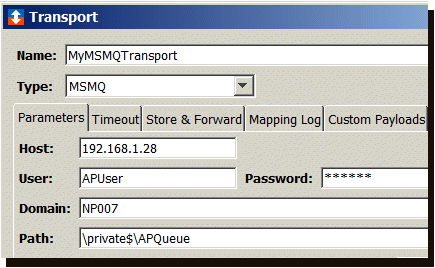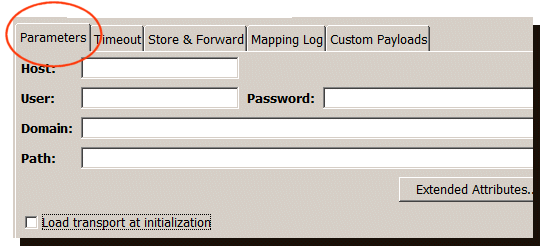It is assumed that the Workbench is started and you have connected to the node that you want to associate the new transport with.
Follow these steps to create an MSMQ transport:
- From the Workbench left pane, expand the node that
you want to associate the new transport with.
- Expand Enterprise, right-click the
Transports icon to display its pop-up
menu, and then click New.
The Transport window appears. - In the Name box, type a unique
name for the transport.
An MSMQ transport name can be up to 64 characters in length and can include letters, numbers, and the underscore character. You will not be able to type invalid characters. For example, spaces are not allowed. You will not be able to insert a space in the name. - Click the Type down arrow, and
then click MSMQ.

The Transport window changes to accommodate the definition of an MSMQ transport.
Parameters tab
| Parameter | Description |
|---|---|
| Host | This is the host name or IP address of the computer where MSMQ is installed. |
| User | This is the user ID to access the MSMQ queue. See your MSMQ administrator for this information. |
| Password | This is the password to access the MSMQ queue. See your MSMQ administrator for this information. |
| Domain
|
If the MSMQ queue is defined on a
computer that is in a Microsoft Active
Directory domain (a managed
environment), then specify the Active
Directory domain name. If the MSMQ
queue is defined on a computer located
in an unmanaged environment then
specify that computer name. Note that the MSMQ queue must be accessed through a managed domain; otherwise, the value in Domain is ignored. |
| Path | Specifies the name of MSMQ
queue. Private queue — For private queues, the syntax is .\private$ [Queue Name] Public queue — For public queues, the syntax is .\ [Queue Name] |
| Extended Attributes | Use this button to display the MSMQ Extended Attributes window. For more information, click Setting extended attributes. |
| Load transport at initialization | Select the Load transport at initialization check box to have the transport connect to the host as soon as the node boots up (or immediately after leaving store and forward). |
Testing and saving the MSMQ transport
The following shows a partial view of the completed MSMQ
transport.
- To test the connection, click Validate. In the case of a MSMQ transport, validation consists of connecting to either the public or private queue environment.
- If no errors are received, click Save. The transport is persisted to the node.
The name of the new transport is added to the Transports tab and will be available for use by a transport map.
